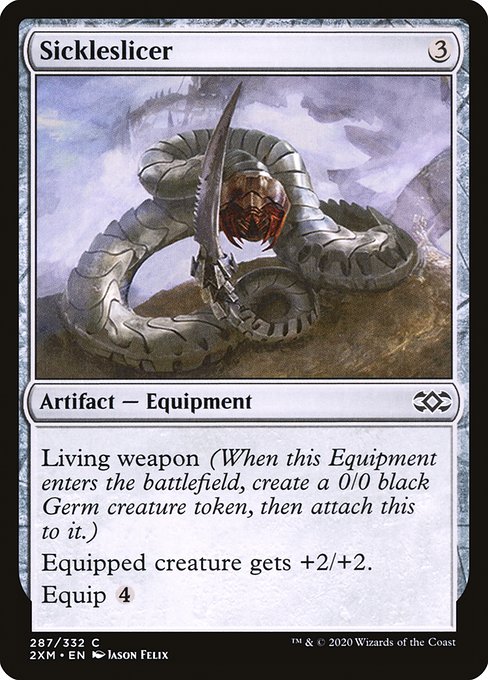
Image courtesy of Scryfall.com
Magic: The Gathering’s visual language has always rewarded fans who read the art as a guide to the card’s mechanics and flavor. Sickleslicer, an artifact — equipment from the Double Masters set, is a prime example of how a single image can echo an entire gameplay philosophy 🧙🔥. Jason Felix’s illustration doesn’t merely show a blade; it suggests a living, breathing tool—one that harvests power as it fuses life and metal. The result is a picture that mirrors the set’s broader visual identity: crisp lines, chrome gleam, and a slightly industrial, laboratory-forge vibe that underlines the ingenuity of artifact-centric design 🎨.
Double Masters arrived as a celebration of the seasoned MTG collector’s toolkit: a treasure trove of reprints, high-gloss finishes, and a distinctly “engineered” aesthetic. Sickleslicer fits this mood with a colorless, high-contrast silhouette—an artifact that embodies the promise of technology and tradecraft. The artwork’s focus on the blade, with its edges catching light as if forged from some alien alloy, aligns with the set’s motif of artifacts as gleaming solutions waiting to be deployed in battle ⚔️. The piece communicates not just “this is a weapon” but “this is a crafted instrument meant to be bonded to a creature and to its wielder’s strategy.”
Design intent: art as a narrative engine
The card’s flavor text (and its mechanical text) hinge on a core MTG archetype: Living Weapon. When Sickleslicer enters the battlefield, it creates a 0/0 black Phyrexian Germ creature token and immediately attaches to it. The Germ token—an echo of Phyrexian design motifs—serves as the living scaffolding for the tool. This dual expectation—an elegant blade that births life—finds a perfect canvas in Felix’s composition. The art suggests that the weapon’s edge is so keen it can sculpt life itself, a visual metaphor for how the equipment’s presence quickly grows in power once attached to a creature ⚙️🧬.
From a visual identity standpoint, the set leans into the tactile sensation of “making” magic. Sickleslicer’s chrome-like gloss, the way light skitters across the blade, and the stark contrast between metal and shadow all reinforce the sense that artifacts are tangible, manipulable forces in the Multiverse. The lack of color identity in the card (no mana color defined) further emphasizes the idea that artifact-focused strategies transcend color lines; the art, too, squares with this by presenting a design language that feels universally mechanical rather than tied to a single shard of mana 💎. The set’s overall aesthetic—bold metallic textures, clean edges, and a laboratory-like atmosphere—receives a clear, practical ambassador in this card.
“Art that suggests a process—not just a result—gives players a heuristic for play.”
That line of thought isn’t just fluff; it’s how players orient themselves around a Living Weapon like Sickleslicer. The equipment entering the battlefield, then attaching itself to the Germ token, is a dance of timing and tempo. The artwork mirrors that tempo: a swift, decisive edge that implies both immediate payoff and ongoing work, a perfect fit for a set that revels in the concept of “make it into something stronger” ⚔️.
In a broader sense, Sickleslicer helps anchor Double Masters’ visual identity within the artifact-centric universe of MTG. The set’s abundant artifact cards, often printed with a strong, metallic sheen and a sense of engineered precision, form a cohesive gallery of must-have pieces for any commander or modern-mavored build. This card’s unfettered, colorless presentation makes it a natural fit in colorless or artifact-heavy decks, where the focus is on raw equipment value and the synergy of living weapons with disciplined board development 🎲.
Art, lore, and the collector’s eye
Artistically, Sickleslicer sits at an intersection of lore and gameplay. The Phyrexian Germ token is a nod to a recurrent theme in MTG’s fiction: corruption and symbiosis—how something living can be coaxed into service by an efficient tool. Felix’s art communicates that theme by placing the blade at the center of the frame, while hints of organic texture creep into the background, suggesting a border between machine and life. It’s a deliberate capture of the card’s “living weapon” identity, a design choice that makes the card a visual anchor for discussions of how artifacts evolve on the battlefield 🧙🔥💎.
For collectors, the Double Masters era is known for its premium presentation and high-contrast imagery. Sickleslicer, while listed as common, benefits from a strong visual clarity that remains striking whether in a binder or on a shelf. The set’s foil treatment tends to elevate these lines and reflections, making the artwork pop in a way that other rarities might not. Even at common rarity, the piece maintains an aura of deliberate craftsmanship, which mirrors the set’s ethos: even the everyday artifact can shine with proper design and presentation ✨.
As you plan a deck or curate a collection, consider how a card like Sickleslicer communicates its identity just through the art. The equipment’s exclusivity to a germ-filled future foreshadows a broader set narrative about growth through attachment—both in mechanical terms and in the story MTG tells around Phyrexia and artifact fusion. It’s the kind of piece that makes you pause, lean in, and imagine the clang of metal meeting dark biology in a forge of magic 🧪⚔️.
Product: Slim Lexan Phone Case for iPhone 16 — View product